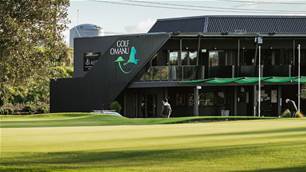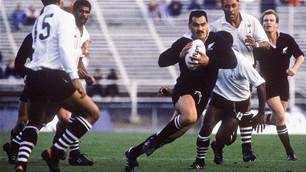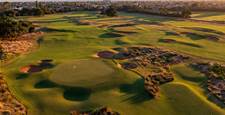Firm, fast and well-bunkered, this western Sydney golf course casts itself in a different light.
Firm, fast and well-bunkered, this western Sydney golf course casts itself in a different light.
Your reviewer’s first memory of the course at Twin Creeks is a dim one – literally. It was a pro-am event three years ago, and our foursome had embarked on its round at the western Sydney layout in the afternoon wave. Modern pace of play being what it is, we had to race the sun to its very last rays. By the time the group reached its final hole, the 9th, we were teeing off into encroaching darkness.
 Your introduction to Twin Creeks - gaping bunkers signal what the golfer will face here from the 1st hole.
Your introduction to Twin Creeks - gaping bunkers signal what the golfer will face here from the 1st hole.
Twin Creeks’ course book describes the 9th as “visually intimidating from the tee”, which we had to take on faith. Golfers often encounter and form impressions about courses and holes when they’re not presented in their best light – but when there’s no light at all, it’s only fair that judgment is postponed.
For this reason, there was added interest to this latest return to Twin Creeks, to see at least how the day version of the 9th compared to the night.
The course is located in Luddenham, at the very edge of the city, an area where if you turn one way, you see suburbia; turn the other, and it’s the countryside. The club and course is the centrepiece of a seven-year-old residential development. In keeping with the lifestyle vision of the place, Twin Creeks is semi-private but prides itself on being a relaxed, modern golf club – have no fear about pulling your mobile phone out on the fairway.
Opened in 2006, the course was designed by Graham Marsh, and it stood profoundly apart from his dozen or so previous Australian designs to that point for its bunkering style. Perhaps inspired by a course he had just finished – Sutton Bay, a minimalist layout in on a dream site in remote South Dakota that has gone on to be acclaimed as Marsh’s finest work – the winner of 56 professional tournaments around the world brought a rugged and ragged look to the sand at Twin Creeks, a sharp contrast to the geometric shapes of his Queensland designs or the pot bunkers of Secret Harbour in Western Australia.

It doesn't get any more pronounced than at the 9th, where the sand figures on every shot on the par-5.
There’s a maxim about the player-turned-course architect, in that the strengths of their golf game influences the way they design courses (admittedly, course critics are altogether too sharp-eyed about looking for these tendencies). Throughout Marsh’s career, the former high school maths teacher was the most calculating of tee-to-green players. His skill set in that area compensated for what fellow player-turned-architect Mike Clayton described as a lack of ability out of the bunker that you would scarcely believe in a touring pro.
Marsh’s driver, ball and scorecard from his first round at Twin Creeks hang in the pro shop – all good for 66 that day, which probably means he plotted his way around intelligently and stayed away from his sandy creations. The number you shoot may be a lot higher, but the test remains the same for every golfer visiting here.
With neither great elevation changes nor tight rows of trees or stakes across the course – with the sole exception of the 15th hole – the 2.5 hectares of bunker very much define the way players approach their round. Twin Creeks rewards those with a plan, who will judiciously lay up short of the sand or take on the carry in equal measure. Between the bunkers, the playing corridors are quite ample, and the reduced rough has had the effect of making the hazards even more threatening. In hard and fast conditions, no wayward shot is likely to be spared from bounding or trickling into the trap.

The short par-3 2nd is a early test of precision, or bunker play.
The 1st clearly sets out what the Twin Creeks experience will be like – great maws of sand appear on both sides from the tee of the par-4, with a massive scheme eating into the front of the green. There’s a bail-out area to the right, but any successive pitch from there is complicated if the hole is in the left half of the green, which slopes away from the player.
The next pair of holes – a short par-3 and driveable par-4 – gives way to the first meaty challenge of the round, a 395-metre two-shotter. A creek that bisects the fairway will leave a shot of at least 120 metres for even the very best drives, to a diagonal green that is raised and shallow to the middle and back left positions. This is the rare hole where sand is not a factor, with a large, front-left swale eating into the green complex that is the dominant feature here.
The 6th is a picture par-3 that sticks in the memory. It’s a mid-iron shot through a chute of trees and over a marsh-like hazard, not really in play but found many times, no doubt. The mitt-like green has something of a false front when coming in from the angle of the member’s tees. The backs, 189 metres out, come in from a vastly different angle which brings bunkers front and back into the line.
The last two holes of the front nine roll out in parallel, and present similarly from the tee. The 8th is a long par-4, 411 metres, but very wide out to the right side. Naturally, the ideal line is left, and that’s where the bunkers are, including one complex that’s 60 metres from the front edge to the far end. The long green is angled from front left to back right, with a sharp ridge line to make sure you put your approach on the correct side if you want to even think about making the putt.
The 9th, true enough, was less visually intimidating in the dark. This chicane-like par-5 winds its way with bunkers seemingly at every hairpin. This is one of those par-5s where players will sweat their lay-up, with a variety of distances and angles to attempt a third shot from as the landing area turns back on itself to the green. It’s a large target, and its overall size disguises a gradual but influential slope.
Past the turn, the 12th ranks as the most fun hole on the course, a very short, driveable par-4 that’s 250 metres to the front, over – you guessed it – another wild collection of bunkers. How driveable is it? It was nothing less than the site of the first hole-in-one at Twin Creeks.
 The 17th: look past the water, and take notice of the large green.
The 17th: look past the water, and take notice of the large green.
At the most eastward corner of the layout, the 14th is a long, uphill par-3 with a bulkhead that makes any miss to the right an adventure on the ensuing shot. The par-4 16th marks the start of an inward stretch of holes where water takes over from sand as the hazard of choice.
It’s less a factor on the 17th, somewhat removed to the left of the par-3, unless the hole is also on the left of the gree. But the water is a genuine threat on the finisher, running all the way along the left side and factoring in on both the drive and approach. The green is also tilted toward the water, and anyone who finds one last bunker for the day in the scheme on the right faces the prospect of having to play a sand shot directly back at splashdown territory.
It’s also of particular note that Twin Creeks’ water levels are very healthy at present, thanks to the rainfall the area has received throughout the year, which augurs well as the course moves into prime playing season.
FACT FILE
LOCATION: Twin Creeks Dr, Luddenham, about 45 minutes from the Sydney CBD.
CONTACT: (02) 9670 8877.
WEBSITE: www.twincreeksgolf.com.auDESIGNER: Graham Marsh (2006).
PLAYING SURFACES: Legends Couch fairways, Creeping Bent greens.
BUNKERS: 74.
PGA PROFESSIONAL: Robert Blain.
GREEN FEES: Private club welcomes interstate and international visitors, $130 (Mon-Thu), $140 (Fri-Sun), includes cart and range balls.
MEMBERSHIPS: Equity-based membership with various categories on offer, including private, family and corporate. Members purchase a share in the holding company that owns the course, clubhouse and other golf facilities. The club is also currently offering a limited number of non-equity memberships.
CORPORATE DAYS: The club offers a customised range of golf and dining packages for groups of 16 to 140. Standard inclusions cover the 18-hole round, carts, registration, organisation of on-course activities, scoring and post-round presentation. Each event had a dedicated event manager, and the club can organise one of its high-profile Ambassadors to participate at the event.
FACILITIES: The club is managed by industry leader Troon Golf. The clubhouse has won a number of architectural awards. The practice facilities are also among the best in the city, with a full-grass, 270-metre driving range with five target greens, as well as chipping green and practice bunker.
19TH HOLE RECOMMENDED FARE: The club’s Paperbark Restaurant serves diners looking for high-end cuisine as well as golfers on the go. An example of its simple, fine fare is the crisp skinned Barramundi fillet with celeriac remoulade.
Related Articles

Drinks With... Ricky Ponting

International Spotlight: Omanu Golf Club








_15th_hole.jpg&h=115&w=225&c=1&s=1)




